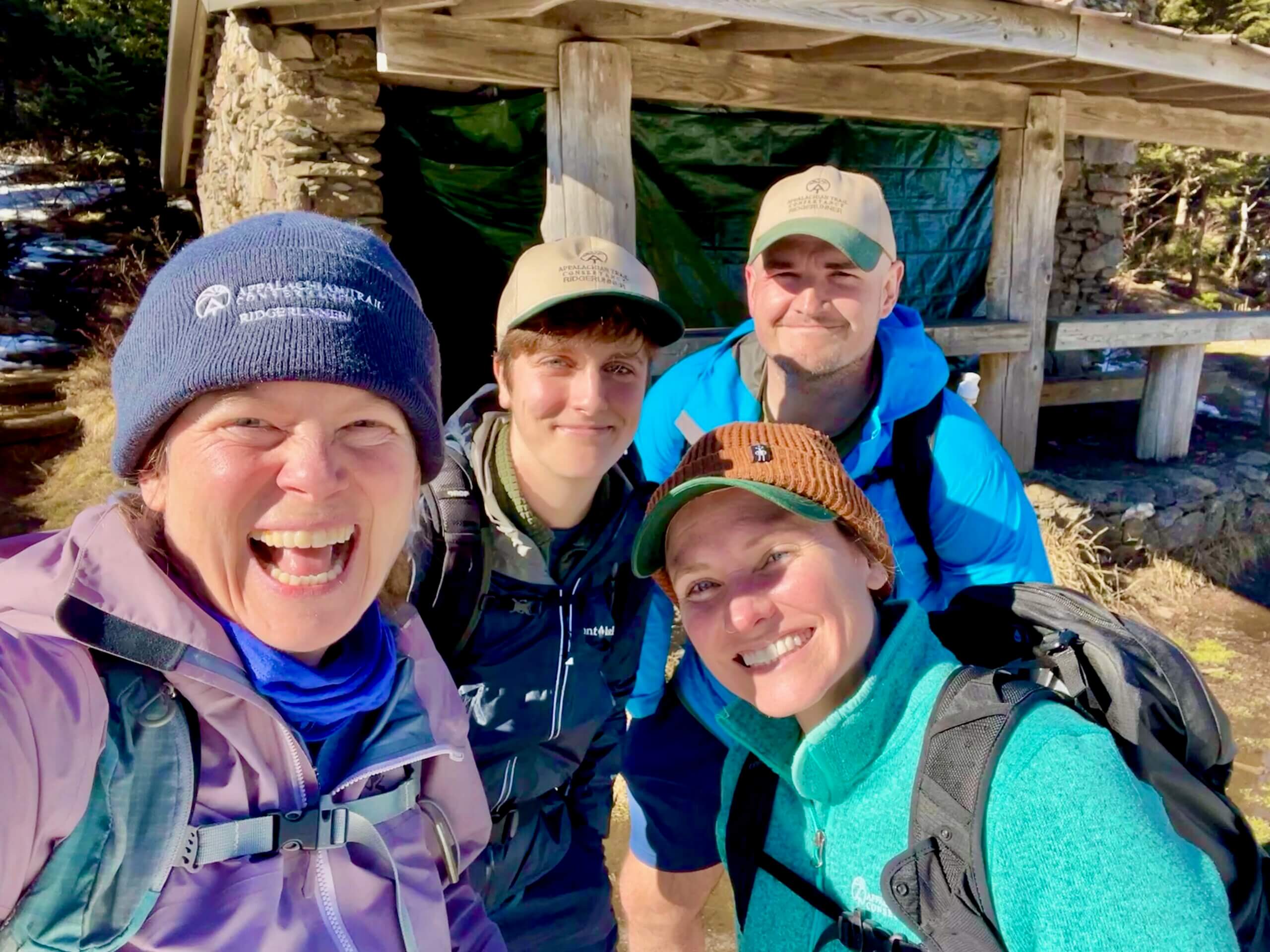by Julie Dodd
Seventy-two miles of the almost 2,200 miles of the Appalachian Trail travel through Great Smoky Mountains National Park. A small group of Ridgerunners play an important role for the enjoyment of thousands people who hike that 72-mile stretch of the A.T.
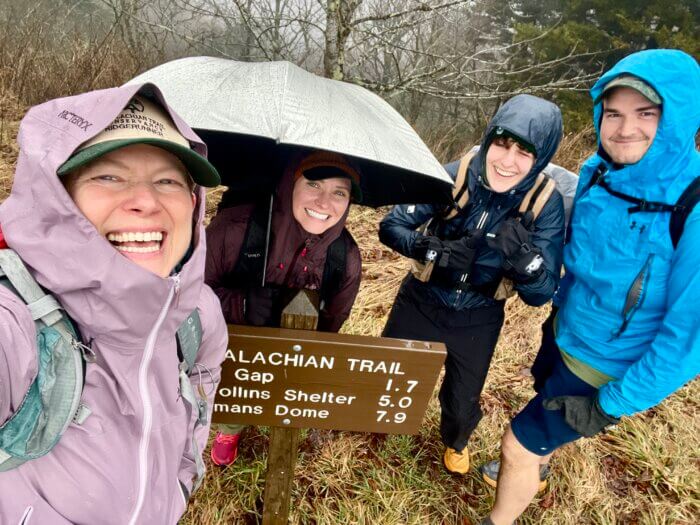
Some of those hikers are section-hikers of the A.T. while others are A.T. thru-hikers attempting the full trail. Thousands more hikers are day hikers or are backpacking for one or two nights.
From February through October, Ridgerunners are on the A.T. in the Smokies to educate hikers and help maintain the shelters and privies.
The Ridgerunner program is coordinated by the Appalachian Trail Conservancy (ATC), Great Smoky Mountains National Park, and the Smoky Mountains Hiking Club.
“The Ridgerunners are so valuable to the A.T.,” said Anne Sentz, ATC Regional Manager for the Smokies and North Carolina.
The A.T. passes through 14 states, and 12 of those states have Ridgerunner programs.
“Ridgerunners are the boots on the ground presence. They are a resource for the hikers and a resource for the A.T.,” she said. “They protect the A.T. and help hikers adhere to ‘Leave No Trace’ practices. They are educators, advocates and stewards.”
Friends of the Smokies support for Ridgerunners
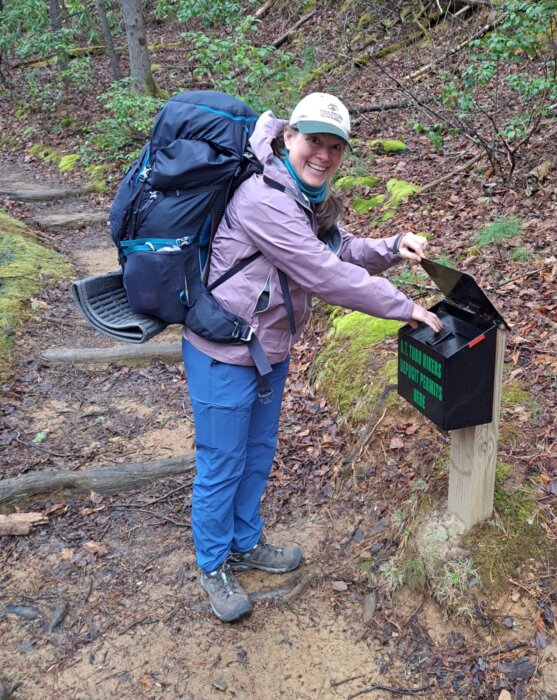
This year Friends of the Smokies provided $55,000 for the Ridgerunner program, almost half the cost of the program.
Funds from Friends pay for Ridgerunner salaries, mileage to and from trailheads, food stipends for the Ridgerunners’ backpacking meals, and some of their gear and supplies — including uniforms and personal protective equipment, first aid kits, and micro spikes for their boots when hiking in ice and snow.
Friends also pays for the Ridgerunners’ two weeks of training, where they earn Wilderness First Aid and CPR certifications.
Ridgerunners are ATC employees, and Sentz is the primary contact for the Ridgerunners. She serves on the interview committee for hiring Ridgerunners, participates in their training, talks with them during weekly team phone meetings, receives their reports from the trail, and checks in with them daily when they are on the AT.
Robust job description
“The job description is very robust,” Sentz said. “They talk to every single hiker they meet to educate and answer any questions. They remind folks that we’re all part of protecting the AT. They are the eyes and ears for all three groups (ATC, the park, and the Smoky Mountains Hiking Club). They let us know if something needs to be addressed that they can’t handle.”
Fallen trees are an example.
The Ridgerunners carry small handsaws and take care of what they can.
“If there’s a large tree that they can’t take care of, they report back to us and we develop a plan. Can the Smoky Mountain Hikers Club hike in and take care of it or do we need to ask for assistance from equestrian volunteers?”
Ridgerunners help injured hikers and may be involved in rescues. So far this year, Ridgerunners have helped with three rescues, including one 16-hour rescue that involved a hiker who had to be airlifted from the AT.
One of the three Ridgerunners is “long season,” working from February through October. The other two are “short season,” working from February through May, the time the most thru-hikers are on the A.T. in the Smokies.
Each of three Ridgerunners works a 4-day shift, hiking one of three A.T. sections – Davenport Gap to Newfound Gap, Newfound Gap to Spence Field, or out-and-back from Fontana Dam to Russell Field.
“It sounds like a fun job, and it is,” Sentz said. “But it’s also a very hard job – taxing mentally and physically.”
The three Ridgerunners for this year are Collin Chambers, Claire Jarvis and James Kinch, all A.T. thru-hikers.
Long Season Ridgerunner Collin Chambers
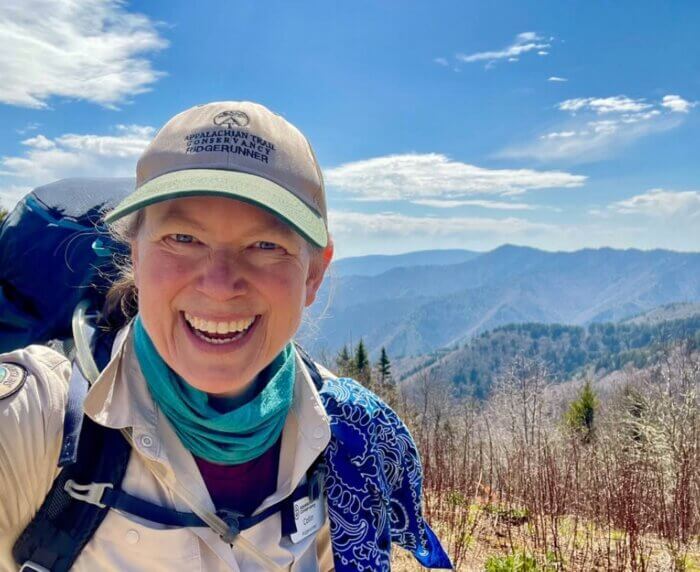
Collin Chambers is the Long Season Ridgerunner and held that position in 2024.
She is a Certified Wilderness First Responder, a Backcountry Survival Instructor, and a “Leave No Trace” Master Educator.
Her hiking experience includes thru-hiking the A.T. in 2010 and trekking in Peru and Mount Everest Base Camp. She’s been a business owner, leads private hikes and backpacking trips, and author of “Wildwood Magic: A Guide to Walking a Sacred Path.”
“There isn’t a week that goes by that I haven’t helped someone on the A.T.,” Chambers said of her Ridgerunner experience. “That’s very fulfilling.”
Chambers read about the Ridgerunner job in the A.T. newsletter in 2023 and decided to apply.
“I just got a spontaneous message that I could serve hiking,” she said.
The timing was good, as she recently had sold her clothing business and had completed a series of treks.
“I wanted to be a Long Season Ridgerunner to be that witness to everything changing – from winter into spring and summer into fall. I wanted to watch the tiniest bits of change. I hike a section and hike it again a week or two later and see it’s so different.”
Chambers captures some of her views of the Smokies in photographs that she posts on her Instagram account.
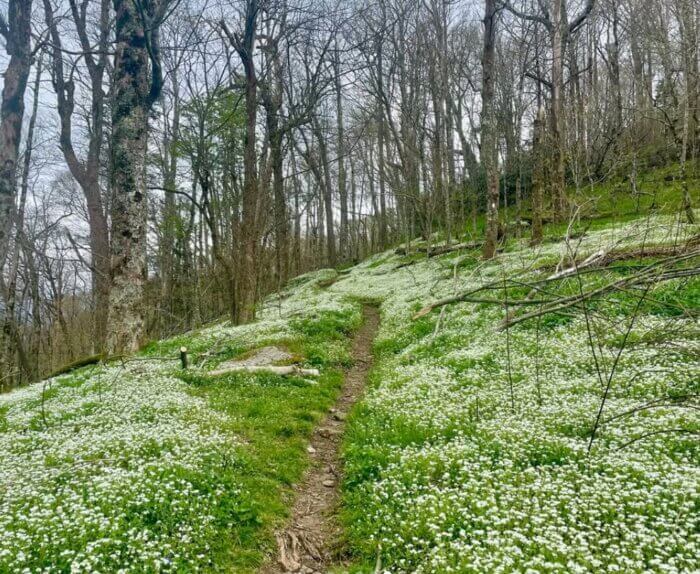
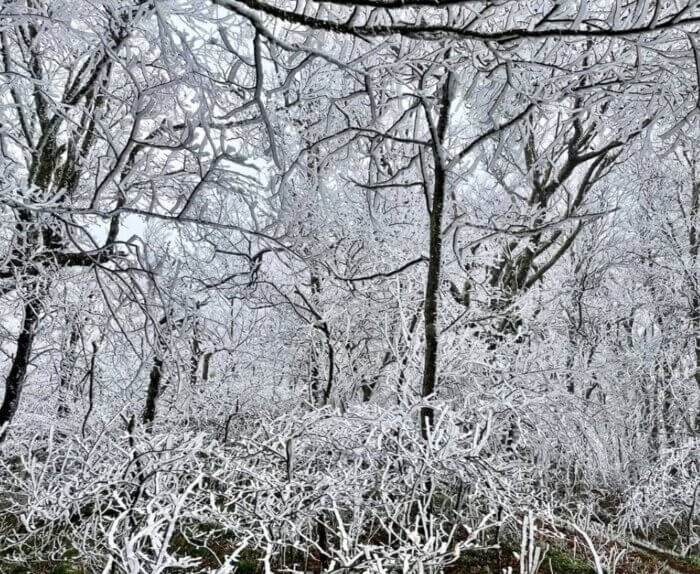
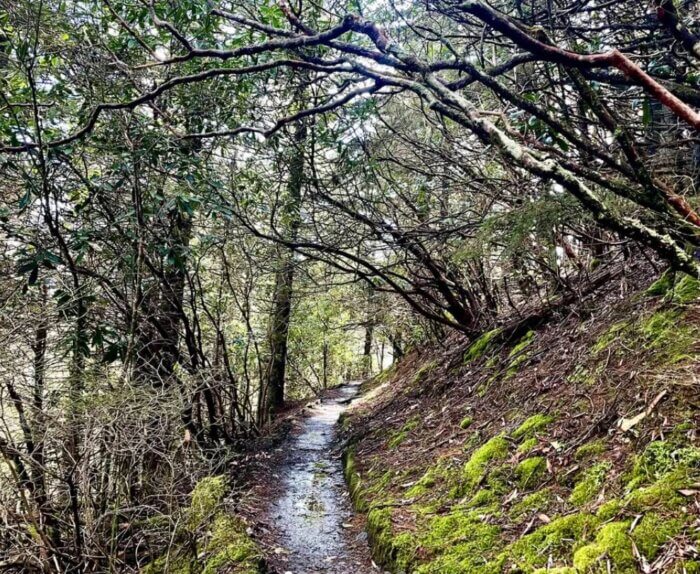
‘Typical’ week for a Ridgerunner
I talked with Chambers about a “typical” week on the trail when she hikes the section from Newfound Gap to Spence Field.
On Thursday, she drives to Cades Cove to park her car at the ranger station. She meets her shuttle driver at 9 a.m., and they drive to Newfound Gap. Chambers is on the trail around 10:30.
Her fully loaded pack weighs about 42 pounds for cold weather and 36 pounds for warm weather. She carries her clothing, camping gear, four days of food, 2 ½ liters of water, a park radio, a Garmin InReach Satellite radio, and a hand saw.
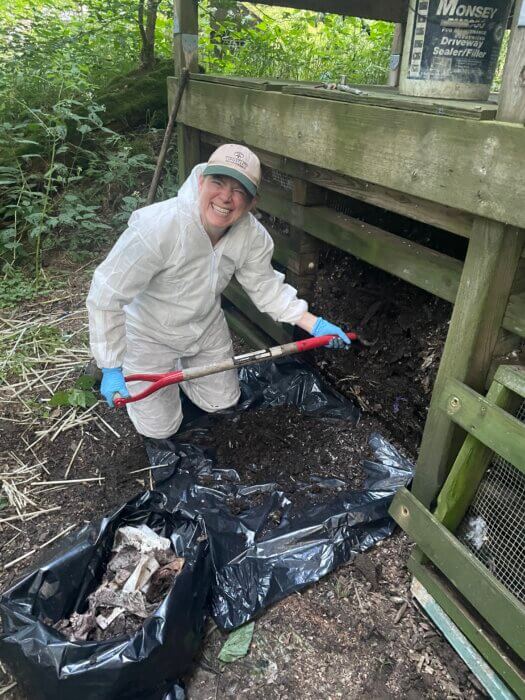
She hikes to the Mount Collins Shelter to provide maintenance and cleaning of the shelter.
Cleaning moldering privy
She cleans the moldering privy that works by using mulch to help decompose human waste.
“The privies have a very delicate balance,” Chambers said. “They don’t operate properly if anything is put into them other than waste and toilet paper.”
Hikers deposit wipes and feminine hygiene products, rather than packing them out. Hikers even throw clothing into the privy. All of those items interfere with composting process and have to be removed, bagged and carried out.
Hikers sometimes discard food in the privy, which can cause bears to break into the privy.
Chambers checks the mulch supply for the privy and makes note if the supply is low. She will pass on that information during the weekly staff meeting, and the Smoky Mountains Hiking Club and other support groups will transport mulch to the privy.
She disinfects the surfaces that people would touch.
Bear cables, trash collection
She checks the bear cables that are used for hanging hikers’ packs.
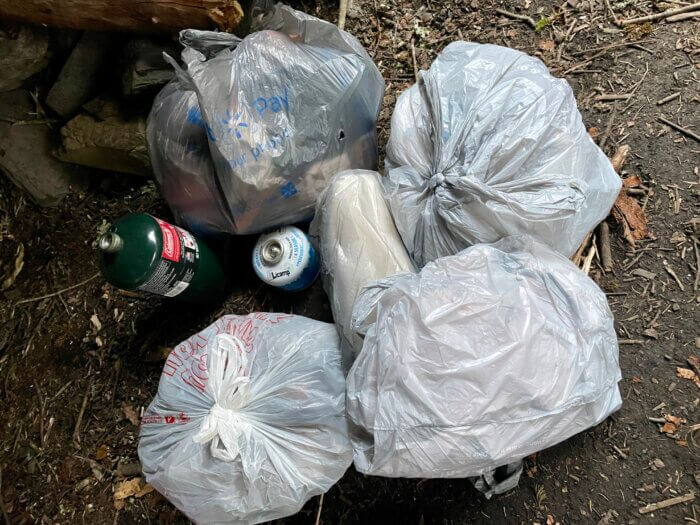
She cleans out the fire pit and the fireplace, checking for trash beneath half-burned logs.
She collects all the trash that hikers have left behind, which she said can include wet socks, clothing and underwear.
“I’ve been finding more and more trash, especially on the north end of the trail,” Chambers said.
A half-full Coleman fuel cannister is an example of a discarded item Chambers had to deal with.
“I think they might be thinking, ‘Oh, someone might want this,’” Chambers said. “But no one who is backcountry hiking is going to use a camp stove that uses that kind of cannister.”
Chambers collects all the trash in a plastic bag, adds the bag to her pack, and hikes on. That additional trash could weigh more than 10 pounds. Sometimes she has several bags of trash and said she always is glad when a hiker volunteers to help carry the trash.
After the Mount Collins Shelter, she hikes on to Double Spring Gap Shelter, typically arriving by mid-afternoon.
“That’s a 12-mile day, which is a pretty big day with going up and over Kuwohi,” Chambers said.
She does the maintenance and cleaning of the shelter and privy.
Educator for hikers
Her time in the shelters with the hikers staying there is a crucial part of her job as an educator.
“With everything, people learn by watching. So, this is an opportunity for Ridgerunners to use best practices for everything,” she said. “I’m on my best ‘Leave No Trace’ behavior.”
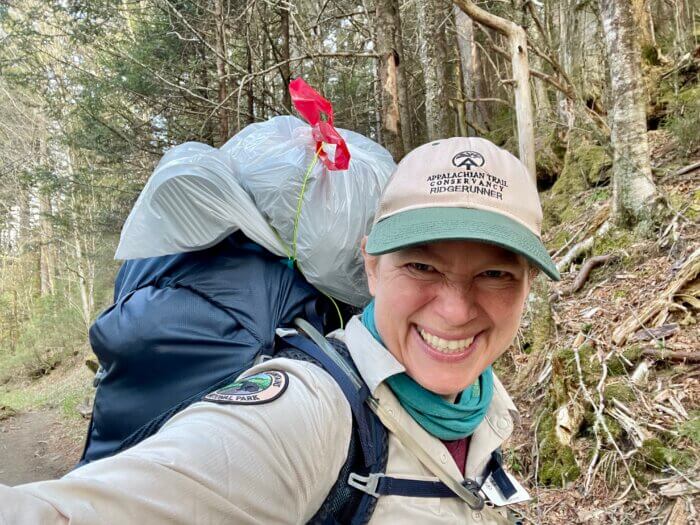
She picks up trash in the shelter as people watch, seeing that she’s even picking up peanut shells and the corner of a food wrapper. She talks about how the scent of even small traces of food can attract bears.
“That can help someone think, ‘I shouldn’t have left that piece of a Pop-Tart that I dropped in the last shelter.’”
She helps hikers learn how to correctly hang their packs with the bear cable.
“Sometimes people use the wrong end of the bear cable,” she said. “I go to where most of the hikers are and explain the correct way, making it a learning explanation with humor – not with scolding or lecturing.”
On Friday, she hikes to the Silers Bald Shelter to clean the shelter and privy and then hikes to Derrick Knob Shelter to clean the shelter and spend the night.
On Saturday, she hikes to Spence Field Shelter for her last night on the trail, where she cleans the shelter and privy.
On Sunday, she hikes off the A.T. to Cades Cove via the Bote Mountain and Anthony Creek Trails. She reaches the ranger station where she parked her car about noon.
“I wake up every day around 6 to 6:30 a.m., and I’m on the trail between 8 and 8:30 a.m., depending on how many hikers I encounter or other factors,” Chambers said.
Sharing trail news
One of the most important parts of her Ridgerunner’s job is being an educator for the 20 to 50 people she meets on the trail every day.
She introduces herself to every hiker, explaining her role as a Ridgerunner and answering questions they might have.
She said that sharing news about the trail is a great way for starting conversations with hikers.
“I talk with hikers about backcountry permits, but I’m also a conveyor of information about water sources or what to expect at the next shelter.”
She shares when she’s seen a bear and has a conversation about bear awareness.
“I tell them to make sure they get all the ‘smellies’ out of their pockets and hang their packs when they are in the shelters,” Chambers said.
“’Thank you for packing out your trash’ is my going-away tagline when I talk with hikers.”


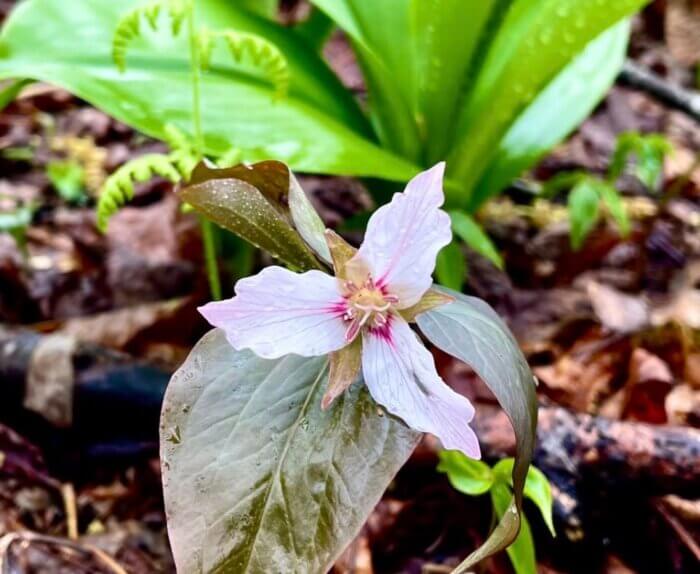
Providing first aid or rescue assistance
Sometimes she provides aid — from basic first aid to teaching hikers how to retie their boots to reduce knee pain. She also is involved in search and rescue events.
Her search and rescue event this year was finding a hiker lying in the trail near Campsite #113, more than five miles from the nearest trailhead.
The hiker had injured a previously injured knee. Chambers assessed his condition, determined he would need help to get to the trailhead, and contacted the park’s Search and Rescue team.
She carried his pack and helped him get back to the campsite and set up for night.
Two Search and Rescue crew members arrived the next morning with special crutches, with big feet and shock absorbers.
Covering the 5.2 miles to Fontana Dam took the group more than six hours, with much of the hike in a thunderstorm. An ambulance met them and took the injured hiker to the hospital.
“I saw the hiker the other day on the trail after he was in rehab for two to three weeks. He called out, ‘There’s my hero.’ That was such a success story,” Chambers said.
“Ridgerunners bring a lot of peace of mind to hikers,” she said. “People are happy to have us in the shelter with them. They want to have their pictures taken with me. It’s a wonderful program, and I appreciate the support of Friends of the Smokies. We’re on the trail because of Friends of the Smokies.”
************
Your Friends of the Smokies license plates and donations help pay for needed programs and projects in the national park that would otherwise go unfunded. You can make a donation to Friends of the Smokies to support the Ridgerunner program and meet dozens of other needs in Great Smoky Mountains National Park.
